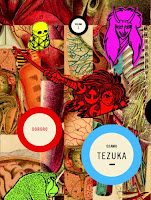 Creator: Osamu Tezuka
Creator: Osamu Tezuka
U.S. publisher: Vertical
ISBN: 9781934287170
Released: June 2008
Original run: 1967-1968
Awards: Eisner Award
Although I’ve read quite a few of the works by Osamu Tezuka that are available English, Dororo remains one of my personal favorites. Dororo is one of Tezuka’s transitional manga, bridging between his earlier, brighter works and his later, more mature stories. Dororo strikes a great balance between its darker elements and its action-adventure leanings. I particularly enjoy Dororo‘s mix of historical fantasy and legend. The manga was originally serialized in Japan between 1967 and 1968. The English-language edition of Dororo was initially published as three individual volumes in 2008 by Vertical, winning an Eisner Award in 2009. That particular edition is now out of print, but fortunately Vertical re-released the series as a single-volume omnibus in 2012. It makes me very happy that the series is still readily available. I’ve read Dororo several times now and am glad that others will still have the opportunity to do the same.
Dororo, Volume 2 continues to follow companions Hyakkimaru and Dororo as they travel across Japan. Outcasts of society, they have no choice but to move from one place to another; they are repeatedly driven out of the villages that they happen across along their way. The two travelers don’t have much, but at least they have each other. Although they might be reluctant to admit it, Hyakkimaru and Dororo make a good team as they face the trials and tribulations encountered on their journey across the war-torn country. Ultimately, Hyakkimaru wants to find happiness and a palace where he can live in peace, but his more immediate concern is to hunt and destroy the demons to which his body was sacrificed by his father. Little does he know that this goal will lead him back to the very family which abandoned him as a newborn, only to result in further tragedy.
Although Hyakkimaru and Dororo must repeatedly confront demons, it is often the humans they encounter who are the true monsters of the story. People can be very cruel to one another and war often brings out the worst. Some of the most horrifying acts committed in Dororo, Volume 2 have nothing to do with ghouls and demons and everything to do with individuals who lust for power and people’s propensity towards violence. Some of the most benevolent characters in Dororo, Volume 2 are actually the inhuman creatures. Even the more kindly people simply can’t bring themselves to accept Hyakkimaru, regardless of the fact that he is often the one who has saved them from the spirits and demons that plague them. Hyakkimaru has come to expect this from others, but the younger Dororo is still frustrated by the situation’s inherent unfairness. Dororo is one of the very few people who is able to completely accept Hyakkimaru for who he is.
One of the things that I enjoy the most about Dororo is the relationship between Hyakkimaru and Dororo. Dororo is a bright kid and is surprisingly optimistic despite having a tragic past. Hyakkimaru, who has certainly seen his own fair share of tragedy, is significantly darker and more world-weary. Their personalities balance each other nicely; both Dororo and Hyakkimaru provide something that the other needs. The human companionship they share is important, especially when living in a world that has rejected them. The two outcasts, even though unrelated by blood, are close enough to be siblings. Hyakkimaru and Dororo have grown quite attached to each other. They have their fights and spats and there’s plenty of good-natured teasing, but they truly seem to care for and look out for the other. Even after several rereads Dororo is still a series that I appreciate and enjoy immensely, especially for its lead characters.




